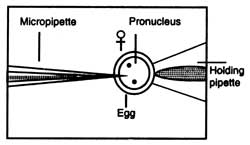Introduction (What is Microinjection?)
Microinjection is a technique of delivering foreign DNA into a living cell (a cell, egg, oocyte, embryos of animals) through a glass micropipette. One end of a glass micropipette is heated until the glass becomes somewhat liquified. It is quickly stretched which forms a very fine tip at the heated end. The tip of the pipette attains to about 0.5 mm diameter which resembles an injection needle. The process of delivering foreign DNA is done under a powerful microscope. Cells to be micro-injected are placed in a container. A holding pipette is placed in the field of view of the microscope. The holding pipette holds a target cell at the tip when gently sucked. The tip of the micropipette is injected through the membrane of the cell. Contents of the needle are delivered into the cytoplasm and the empty needle is taken out.

Microinjection Services
Microinjection (MIJ) services consist of the instruments, facilities, and technical expertise required for microinjection, which is a necessary step in the creation of genetically modified mouse models. Carry out daily activities such as mouse colonies management, pro-nuclear, embryo collection, cytoplasm, superovulation, embryo injection and embryo transplant. These services include microinjection or DNA structure of CRISPR reagents, including BAC (bacterial artificial chromosomes), injection of enzymes for many inbreeding and special strains. Leading biology provides ES cell injections for blastocyst and 8-cell embryos in mouse strains, and uses coating color schemes wherever possible to facilitate the evaluation of cytosis. MIJ services have also been very successful in creating knockout animal models directly on inbreeding and specialty strains using ZFN (zinc finger nuclease) and TALEN (transcription activators, such as psynocoline nucleases) techniques. The microinjection service has 5 complete microinjection stations and 3 complete surgical stations. Key equipment includes 6 benchtop incubators, 3 XYClone laser systems, 2 stereo microscopes, 3 Vet Equip anaesthetic machines, 2 Kopf micropipist pullers, 2 piezoelectric drills and 3 micro-forging machines.
The process of transporting foreign DNA is done under a powerful microscope. The cells to be microinjected are placed in a container. Place a hold pipette in the microscope's field of view. Keep the pipette holding the target cells at the tip when sucking gently. The tip of the micropipette is injected through the cell membrane. The contents of the needle are transported into the cytoplasm and the empty needle is removed. For processes such as cell or pro-nuclear injection, the target cell is located under a microscope and two micromanipulators (one holding a pipette and one holding a micro-hair thin needle between 0.5 and 5 microns in diameter (larger if the stem cells are injected into the embryo) are used to penetrate the cell membrane and/or nuclear envelope. In this way, the process can be used to introduce vectors into a single cell. Microinjectioncans can also be used for the cloning of organisms, the study of cell biology and viruses, and the treatment of male sub-breeding children through intracellular sperm injection.
Advantages of Microinjection Services
it allows precise control over
(1) the amount of reagent introduced into the cell;
(2) the time of introduction;
(3) the specific cell(s) into which the reagent is introduced.
Mouse Model Production:
Why Leading Biology?
At Leading Biology, we custom protein purification design for every single protein to ensure the production and recovery rate as high as possible.
Working with us, you will get stability, and it means a reliable partner to help streamline your R&D process.
Working with us, you will get the guaranteed service to accommodate your requirements.
· Vigorous quality control system to ensure the required quality and reproducibility
· Competitive price with fast turnaround time
Contact Information
Please obtain a quote before ordering, and refer to the quote number when you place an order.
Orders are typically confirmed within 12 hours.
Have a Question? Email us info@leadingbiology.com
Order Products: Order Related Products
By Phone: 1-661-524(LBI)-0262 (USA)
| No | Headline | Click | Author | Date |
| 1 | siRNA/shRNA gene knockdown | 1737 | Leading Biology | 2018-01-26 |
| 2 | Tetracycline Induced Gene knockout/knockin | 1939 | Leading Biology | 2018-01-26 |
| 3 | New Generation Embryonic Stem Cells Gene Targeting | 1938 | Leading Biology | 2018-01-26 |
| 4 | TALEN Technology | 1781 | Leading Biology | 2018-01-26 |
| 5 | CRISPR-CAS Technology | 2204 | Leading Biology | 2018-01-26 |
| 6 | Microorganisms Gene Modification Services | 1673 | Leading Biology | 2018-01-26 |